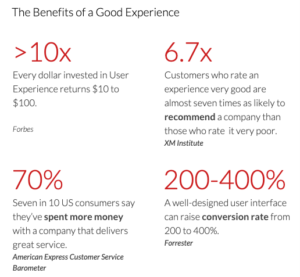Reap the Benefits of Making Design an Integrated Part of Your Project
If your project requires major design inputs, such as in a new implementation or a site re-design, making sure the design effort is synchronized with the development effort is one of the keys to success. The benefit of tight coordination between design and development are many. Let’s take a look at a few of them!
Design Output is a Core Development Team Input and Dependency
Inputs from the design team are perhaps the single most critical contribution to your project. Keeping design activities integrated with the project schedule, architecture design, and development activities can lead to a positive and successful product and project outcome more than any other dependency of your project.
Although there is always work the development team can do while designs are being completed, such as requirements gathering and documentation, site structure, architecture, security, backend process documentation and solutioning, the core AEM development will be delayed if the design team is delayed. Additionally, delays will occur if the designs delivered are not complete, approved and reflective of what the customer will be satisfied with as well. A delay in receiving designs is often the largest risk to an AEM project and one of the core causes for scheduling delays and increased budgets.
The Design Team is the Front Line
The Design team is the front line. Their responsibilities include interfacing with the customer’s leadership and business teams and capturing the goals of the business and users. The design team must drive the customer to and through major strategic decisions that will determine the functionality, quality, feel, effectiveness, and success of the site being built. There are critical and strategic decisions that must be made, and they must be made in a timely manner and in alignment with the overall project timelines. Making the Design Team an integrated part of the project and keeping them fully integrated helps reiterate, drive, and make transparent this uber critical factor of success. The downstream impact the various teams and efforts have on one another must be made and kept visible and transparent to all stakeholders, from day one (kickoff, or even in pre-sales).
Good Design is Good Business
Making a site easy and enjoyable to use drives business, order conversion, utilization, repeat business, and referrals and that drives customer ROI and satisfaction.

Development Best Practices Start with Design Best Practices
In addition to being a delight for users to navigate through and utilize from a functional standpoint, a well-designed site must be easy to maintain and easy to modify to drive business and marketing objectives and activities. The creation, use, and re-use of site content and site components can make a site easier to maintain and update, and this can lead to greater utilization at lower costs. The greater the use of out-of-the-box (OOTB) functionality to achieve business goals, the lower the cost and timeline to deliver and maintain. Tight and continuous integration between design and development teams drives the collaboration needed to accomplish these goals.
Drive Development Efficiency and Minimize Rework
With the goal of aligning all project activities to best practices, the design and development teams should discuss and agree upon the order in which the various pages and site components should be designed, when the designs will be completed and approved by the customer, and finally, handed over to the development team. Doing so is critical to effective and streamlined development, minimized delay and rework, maximized customer satisfaction, and delivery that meets the customer’s requirements and objectives.
There is a natural order any project builds to. Design and development working together to that natural order allows for a better and more cost / risk efficient delivery. And this will translate to increased project success. The design team being in lockstep with the development team and its needs will allow the design team to take that knowledge and priority and use it as a framework to lead and drive customer interfacing objectives and activities, schedules, priorities, sense of urgency, approval processes, and delivery outputs.
Establishing the Framework for Design / Development Collaboration
What steps should you take as a project manager to make sure the design team is fully integrated?
1) Include the design team in all agile development operations and ceremonies.
- Sprint Plan: A section of the sprint plan should show the design deliverables, and the schedule of those deliverables should reflect the best practices schedule agreed via design/development collaboration.
- Sprint Ceremonies: Include design team members in sprint operations, meetings and ceremonies. Meet with the design team leads at kickoff and start framing up the sprint calendar and ceremonies. You will want to agree on which ceremonies design and development will combine and which ceremonies should be kept separate. At minimum, both teams should be present at daily stand-ups to give everyone that single, consistent daily touchpoint to collaborate.
2) Calendar Key Design / Development Touchpoints Early
The goal is to make sure the necessary touchpoints are in place, but to keep them as short as possible. It’s always better to have the meeting in place in a regular slot. You can then give time back as often as possible.
Below are the meetings you might consider:
Weekly Project Status: Include the design team lead(s) only. The core design team lead will tell you who he/she feels needs to be on.
Daily Sprint Stand-Up: Include all members of the design team and anyone actively working on stories, tasks, deliverables, or bugs. The design team lead will likely coordinate with his/her team about any exceptions.
Weekly Design/Dev Tech Synch: Include the design team leads and other participants they designate. This meeting is nuts and bolts coordination between the teams, to discuss:
- Reviews
- Solutioning
- Q&A
- Coordination & Scheduling
Suggestion: Set for 60 minutes and shorten or cancel when necessary.
Integrate the Design Team into Your Project from the Get-go and Win!
Don’t underestimate the power of integrating your design team into your project early on. Your teams will appreciate the collaboration, camaraderie, and ability to provide the optimal solution to your customer. Sharing input, creating visibility, utilizing best practices, and improving overall efficiency between your development and design teams are all great drivers for success.

